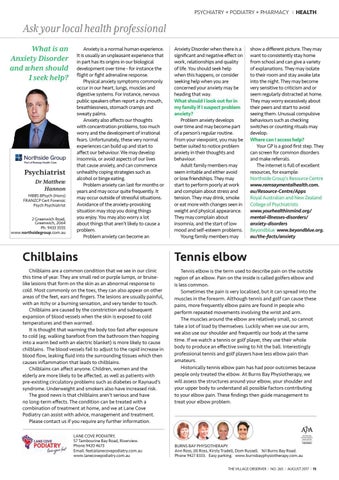PSYCHIATRY + PODIATRY + PHARMACY I HEALTH
Ask your local health professional What is an Anxiety Disorder and when should I seek help?
Psychiatrist Dr Matthew Hannon MBBS BPsych (Hons) FRANZCP Cert Forensic Psych Psychiatrist 2 Greenwich Road, Greenwich, 2064 Ph: 9433 3555 www.northsidegroup.com.au
Anxiety is a normal human experience. It is usually an unpleasant experience that in part has its origins in our biological development over time - for instance the flight or fight adrenaline response. Physical anxiety symptoms commonly occur in our heart, lungs, muscles and digestive systems. For instance, nervous public speakers often report a dry mouth, breathlessness, stomach cramps and sweaty palms. Anxiety also affects our thoughts with concentration problems, too much worry and the development of irrational fears. Unfortunately, these very normal experiences can build up and start to affect our behaviour. We may develop insomnia, or avoid aspects of our lives that cause anxiety, and can commence unhealthy coping strategies such as alcohol or binge eating. Problem anxiety can last for months or years and may occur quite frequently. It may occur outside of stressful situations. Avoidance of the anxiety-provoking situation may stop you doing things you enjoy. You may also worry a lot about things that aren’t likely to cause a problem. Problem anxiety can become an
Anxiety Disorder when there is a significant and negative effect on work, relationships and quality of life. You should seek help when this happens, or consider seeking help when you are concerned your anxiety may be heading that way. What should I look out for in my family if I suspect problem anxiety? Problem anxiety develops over time and may become part of a person’s regular routine. From your viewpoint, you may be better suited to notice problem anxiety in their thoughts and behaviour. Adult family members may seem irritable and either avoid or lose friendships. They may start to perform poorly at work and complain about stress and tension. They may drink, smoke or eat more with changes seen in weight and physical appearance. They may complain about insomnia, and the start of low mood and self-esteem problems. Young family members may
show a different picture. They may want to consistently stay home from school and can give a variety of explanations. They may isolate to their room and stay awake late into the night. They may become very sensitive to criticism and or seem regularly distracted at home. They may worry excessively about their peers and start to avoid seeing them. Unusual compulsive behaviours such as checking switches or counting rituals may develop. Where can I access help? Your GP is a good first step. They can screen for common disorders and make referrals. The internet is full of excellent resources, for example: Northside Group’s Resource Centre www.ramsaymentalhealth.com. au/Resource-Centre/Apps Royal Australian and New Zealand College of Psychiatrists www.yourhealthinmind.org/ mental-illnesses-disorders/ anxiety-disorders Beyondblue www.beyondblue.org. au/the-facts/anxiety
Chilblains
Tennis elbow
Chilblains are a common condition that we see in our clinic this time of year. They are small red or purple lumps, or bruiselike lesions that form on the skin as an abnormal response to cold. Most commonly on the toes, they can also appear on other areas of the feet, ears and fingers. The lesions are usually painful, with an itchy or a burning sensation, and very tender to touch. Chilblains are caused by the constriction and subsequent expansion of blood vessels when the skin is exposed to cold temperatures and then warmed. It is thought that warming the body too fast after exposure to cold (eg. walking barefoot from the bathroom then hopping into a warm bed with an electric blanket) is more likely to cause chilblains. The blood vessels fail to adjust to the rapid increase in blood flow, leaking fluid into the surrounding tissues which then causes inflammation that leads to chilblains. Chilblains can affect anyone. Children, women and the elderly are more likely to be affected, as well as patients with pre-existing circulatory problems such as diabetes or Raynaud’s syndrome. Underweight and smokers also have increased risk. The good news is that chilblains aren’t serious and have no long-term effects. The condition can be treated with a combination of treatment at home, and we at Lane Cove Podiatry can assist with advice, management and treatment. Please contact us if you require any further information.
Tennis elbow is the term used to describe pain on the outside region of an elbow. Pain on the inside is called golfers elbow and is less common. Sometimes the pain is very localised, but it can spread into the muscles in the forearm. Although tennis and golf can cause these pains, more frequently elbow pains are found in people who perform repeated movements involving the wrist and arm. The muscles around the elbow are relatively small, so cannot take a lot of load by themselves. Luckily when we use our arm, we also use our shoulder and frequently our body at the same time. If we watch a tennis or golf player, they use their whole body to produce an effective swing to hit the ball. Interestingly professional tennis and golf players have less elbow pain than amateurs. Historically tennis elbow pain has had poor outcomes because people only treated the elbow. At Burns Bay Physiotherapy, we will assess the structures around your elbow, your shoulder and your upper body to understand all possible factors contributing to your elbow pain. These findings then guide management to treat your elbow problem.
LANE COVE PODIATRY, 57 Tambourine Bay Road, Riverview. Phone 9420 4673 Email: feet@lanecovepodiatry.com.au www.lanecovepodiatry.com.au
BURNS BAY PHYSIOTHERAPY. Ann Ross, Jill Ross, Kirsty Tradell, Dom Russell. 161 Burns Bay Road. Phone 9427 8333. Easy parking. www.burnsbayphysiotherapy.com.au THE VILLAGE OBSERVER I NO. 265 I AUGUST 2017 I 15





